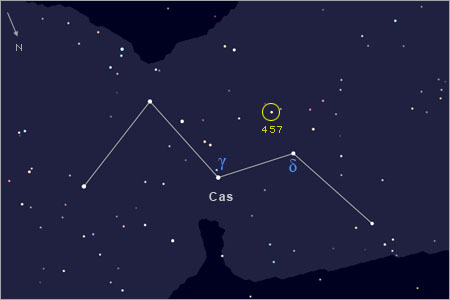|
NGC 457
Exposure Data
- Image Field of View: 21.3' x 14.2'
- Camera Field of View: 27.5' x 17.6'
- Scope: 11-inch Aplanatic Schmidt-Cassegrain
- Focal Length: 2,794 mm
- Focal Ratio: f/10
- Camera: Modified Canon T2i (550D)
- Exposure / ISO: 105 minutes total
- 2 x 600 seconds at ISO 1600
- 4 x 600 seconds at ISO 400
- 3 x 600 seconds at ISO 200
- 3 x 300 seconds at ISO 100
- Filter: None
- SQM: 20.81
|
|
NGC 457 is a beautiful open cluster in Cassiopeia that is known by the popular names of the Owl Cluster, Dragonfly, or ET Cluster, from the movie ET, The Extra-Terrestrial.
The eyes of the Owl, or ET, are comprised of the two brightest stars in the image, Phi-1 and Phi-2 Cassiopeiae, which are magnitude 5 and 7 respectively.
NGC 457 is located two degrees south-southwest of Ruchbah (Delta Cassiopeiae). It was discovered in 1787 by William Herschel. It has an apparent diameter of 13 arcminutes and an apparent magnitude of 6.4. It lies 8,000 light-years away and is estimated to be 21 million years old.
North is to the bottom in the above image.

|
NGC 457
- Catalogs: NGC 457, OCL 321
- Common Name: Owl, ET, Dragonfly
- Object Type: Open Cluster
- Magnitude: 6.4v
- Size: 20'
- Constellation: Cassiopeia
- Image Field Centered At:
- RA: 01h 19m 38s
- Dec: +58° 16' 52"
|
|
